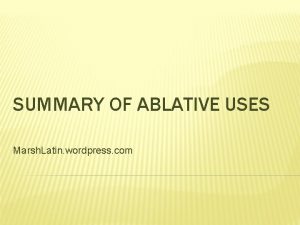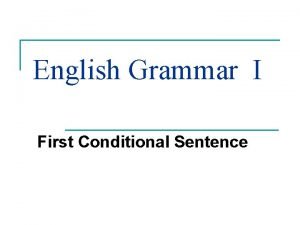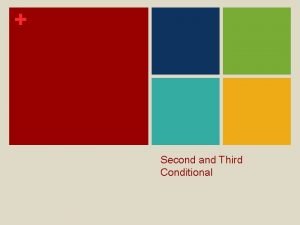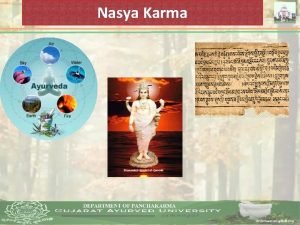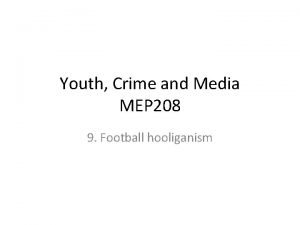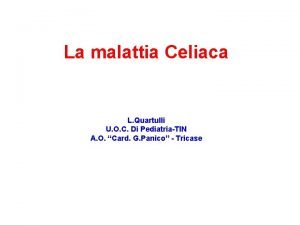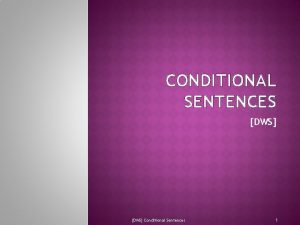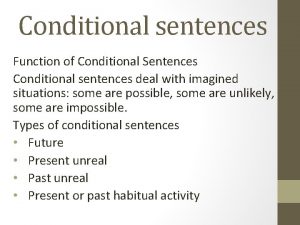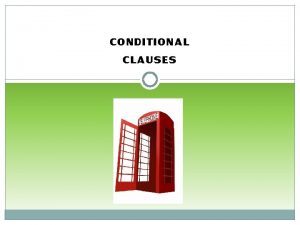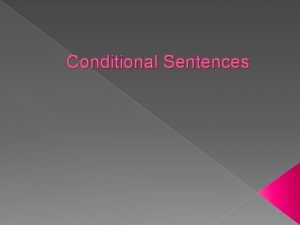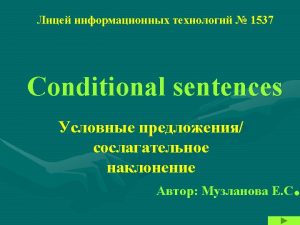Conditional Sentences Marsh Latin wordpress com What is













- Slides: 13

Conditional Sentences Marsh. Latin. wordpress. com

What is a conditional sentence? �Any sentence that uses the word “if” in English (“si” in Latin) is a CONDITIONAL SENTENCE. �A conditional sentence is one in which the first half of the sentence affects the veracity (truthiness) of the second half. �EXAMPLE: �If I study I will get an “A” on the test

The Two Halves �Conditional Sentences are always made up of at least two parts (clauses): �The “if” clause of the sentence is called the PROTASIS �The “then” clause of the sentence is called the APODASIS �Realize that the protasis is not always the first clause.

Conditional Sentences in Latin �In Latin we categorize conditional sentences based on the TENSE and the MOOD of the protasis/apodasis. �Latin Conditional Sentences fall into two basic types: GENERAL (aka simple) and CONTRAFACTUAL (aka contrary-to-fact) �The tenses of Latin conditional sentence are straightforward: present, past, and future

GENERAL vs CONTRAFACTUAL �The two major types of conditional sentences reflect the MOOD of the verb in each clause. �GENERAL conditionals are in the INDICATIVE MOOD �CONTRAFACTUAL conditionals are in the SUBJUNCTIVE MOOD

GENERAL conditions �GENERAL conditional statements are made when the relationship between the PROTASIS and the APODASIS generally seems to be true: �If I study I earn an A �If I have been studying I have earned an A �If I study I will earn an A �Because GENERAL conditionals are inherently true they operate in the INDICATIVE MOOD

CONTRAFACTUAL conditions �CONTRAFACTUAL conditional statements happen when the PROTASIS does not seem to be true (making the APODASIS potentially false as well). �If I were studying I would earn an A �If I had studied I would have earned an A �If I should study I would earn an A �Because CONTRAFACTUAL statements are inherently untrue they all operate in the SUBJUNCTIVE MOOD

PRESENT CONTRAFACTUAL Imperfect subjunctive imperfect subjunctive Si dure studerem, bene facerem If I were studying hard (but I’m not…I’m watching Sparticus for the 15 th time…) I would be doing well These use an IMPERFECT SUBJUNCTIVE in both clauses. NOTA BENE: Impf subjunctive = 2 nd pp + personal endings

PERFECT CONTRAFACTUAL �Pluperfect subjunctive �Si dure studuissem, bene fecissem �If I had studied I would have done well �These use a pluperfect subjunctive for both clauses �Nota Bene: pluperfect subjunctive = 3 rd pp +isse + personal endings

FUTURE CONTRAFACTUAL �More commonly known as FUTURE LESS VIVID �Also known as should-would �Present subjunctive �Si dure studeam, bene faciam �If I should study hard I would do well �NOTA BENE: present subjunctive = 1 st pp + w. E b. EAt A l. IAr + personal endings

Condition type Verb in conditional clause (protasis) Verb in main clause (apodosis) Simple fact—present Present indicative Simple fact—past Imperf/perfect indicative Simple fact—future a. k. a future more vivid Present/future indicative Future indicative Contrary to fact—present Impf subjunctive Contrary to fact – perfect Pluperfect subjunctive Pluperfect Subjunctive Contrary to fact – future a. k. a. Present subjunctive future less vivid Present subjunctive

EXAMPLES FROM DBM 5. 29 Si nihil esset durius, nullo cum periculo ad proximam legionem perventuros (esse) If nothing were difficult then they would come to the nearest legion with no danger Si Gallia omnis cum Germanis consentiret, unam esse in celeritate positam salutem If Gaul were agreeing with all of Germany, the one safety would be placed in speed. NOTA BENE: both these examples use IMPERFECT SUBJUNCTIVE in the PROTASIS and are examples of PRESENT CONTRAFACTUAL

Strategies to help you remember… Recognize the patterns for subjunctives: Present subjunctive = We beat a liar Imperfect subjunctive = Infinitive form + personal endings Pluperfect subjunctive = 3 rd part + isse + personal ending It seems odd that the Contrary to Fact—Present uses imperfect? Think about how we say it in English: If I were on vacation right now (but I’m not, I’m here teaching Latin), I would be swimming and getting a tan. We use the imperfect, too!


